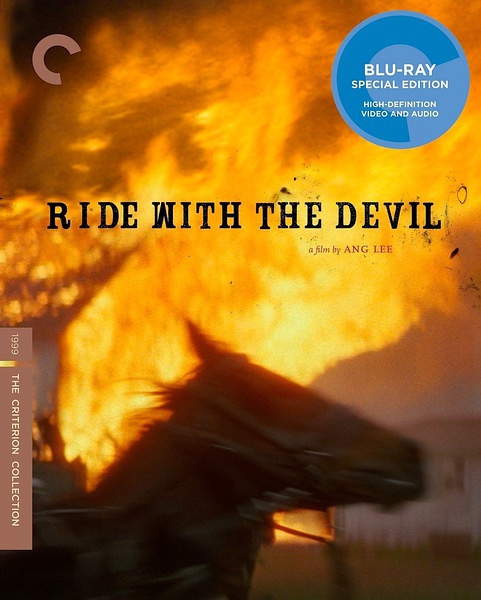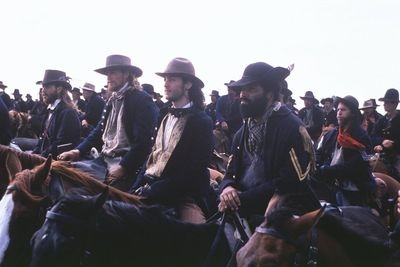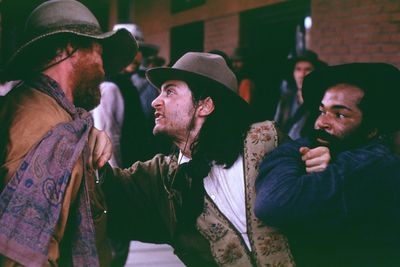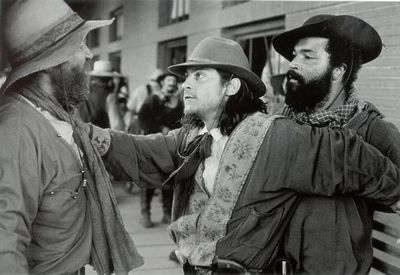
與魔鬼共騎 Ride with the Devil (1999)
導演: 李安
編劇: 詹姆斯夏慕
主演: 史基艾瑞克 陶比麥奎爾 珠兒 傑弗瑞萊特
類型: 劇情 / 愛情 / 戰爭 / 西部
製片國家/地區: 美國
語言: 英語
上映日期: 1999-09-09(杜維爾電影節) / 1999-11-24(美國)
片長: 138分鐘 / 148分鐘(導演剪輯版)
又名: 亂世恩緣 / 與魔鬼同騎
劇情簡介
故事背景是美國的內戰。 1861年,南部邦聯成立,內戰隨即爆發。當軍隊在前線作戰,許多南方的支持者也組成遊擊隊,在各州邊境打遊擊。在堪薩斯州及密蘇裡州的邊境,兩個兒時玩伴傑格羅德(陶比麥奎爾飾),在密蘇裡長大的德國後裔,及傑克布爾柴斯(史基特烏瑞奇飾),農場主人的兒子,也加入了遊擊隊。他們必須在極短的時間內學會射擊和騎術,以打擊北軍和他們的支持者。而同隊的遊擊隊員還有彼特麥克森(強納森萊斯梅爾)、喬治克萊德(西蒙貝克)及克萊德忠貞的黑奴丹尼爾赫特(傑弗瑞萊特),由隊長布萊克約翰(詹姆士卡維索)領軍。
冬天漸漸來臨,遊擊隊必須暫時解散,尋找過冬的地方。一些隊員便暫時在山上的防空洞落腳。這時,他們認識了富同情心的年輕寡婦蘇莉(珠兒飾),為他們黑暗寒冷的冬天帶來了一線曙光。但戰爭的現實面讓整個遊擊隊崩潰瓦解,只有傑格和赫特兩個外來人團結在一起。春天來臨後,戰爭的局勢變得更加緊張,而這群年輕人也面臨人生的重大轉捩點。

拍攝花絮
·本片是歌手珠兒首次登上銀幕。
·襲擊堪薩斯勞倫斯的場景其實是在密蘇里的帕頓斯堡拍攝完成,當地曾經遭遇1993年的大洪水,居民被重新安置,帕頓斯堡隨即成為一座空城。

幕後製作
1861年,隨著美國南北戰爭的打響,堪薩斯和密蘇里州涉世未深的懵懂青年在一夜之間被捲入這場戰爭,他們寶貴的純真很快被戰火淹沒。有感於被戰爭吞噬的純真,出生在密蘇里州的丹尼爾·伍德瑞爾於1987年創作了小說《Woe to Live On》,是電視中兒童揮舞自動武器的新聞畫面激發了伍德瑞爾的創作靈感,他由此想到了在堪薩斯大學就讀期間研究的叢林游擊隊。 “美國南北戰爭其實與越戰、波黑戰爭和尼加拉瓜內戰頗為相似,那就是鄰里之間反目成仇,家人之間兵戈相見,”伍德瑞爾說,“南北戰爭的破壞力是巨大的,這場戰爭早在官方宣布開戰之前便開始了,而報復襲擊一直延續到戰爭結束之後。”
伍德瑞爾重新研究了相關歷史,他驚訝的發現南方軍的行列中竟出現過黑人:“這些黑人是出於友誼而拿起武器,可一旦更重要的動機成為生活的中心,他們意識到並不是在為自己的利益而戰。”伍德瑞爾還對當時年輕人經歷的矛盾和經驗短缺很感興趣,他說:“我希望解讀他們的人性,對於年僅25歲的小伙子來說,成為騎兵隊長並置身於腥風血雨之中絕非易事,在沒有男歡女愛的戰場上歷經三、四個年頭的煎熬超乎想像。”
人性同樣是李安一直以來關注的焦點,他的電影雖然跨越了不同時間和地域,但始終聚焦於角色的人性。李安一直在尋求一部能展現他導演天賦的非同以往的類型片,是副製片人安妮·凱瑞將伍德瑞爾的小說推薦給李安。 “在閱讀小說時,我的腦海中就閃現出影片畫面,”深受打動的李安說,“一群正在成長中的年輕人經歷了美國最糟糕的歷史時期,隨之而來的故事情節激動人心,我喜歡其中自我解脫的主題。”
本片的孕育過程有些漫長,因為李安、編劇詹姆士·沙姆斯和製作人泰德·霍珀當時正在籌拍《冰風暴》,不過幾位主創都深知本片將是三人合作以來最具野心的重頭戲。在《冰風暴》進入後期製作之後,《與魔鬼共騎》的前期製作很快展開,製片方與堪薩斯城、密蘇里電影委員會和堪薩斯電影委員會密切協作,在堪薩斯和密蘇里兩州選定了十多處外景地,本片由此在當地創下了電影拍攝的規模之最。

With this new director’s cut, Ang Lee reconstructs his original vision for Ride with the Devil, a harrowing, unorthodox Civil War epic. Set during the Kansas-Missouri border war, the film follows Jake (Tobey Maguire) and Jack Bull (Skeet Ulrich), who join the Confederate-sympathizing Bushwhackers after Jack Bull’s father is killed by abolitionist Jayhawkers, and find an unusual ally in Holt (Jeffrey Wright), who’s fighting for the South despite being a former slave. A rumination on identity and loyalty, both political and personal, Ride with the Devil is a provocative challenge to preconceptions about America’s bloodiest conflict.

Ride with the Devil:
Apocalypse Then
By Godfrey Cheshire
Just over halfway through Ang Lee's masterful Civil War drama Ride with the Devil, the small group of men at the story's center, young, Southern-sympathizing Bushwhackers fighting in divided Missouri, meet up with other ragtag bands of rebels. Coalescing under the command of Captain William Clarke Quantrill (John Ales), these freelance warriors are arresting—and more than a little frightening—in their suddenly massed numbers and in the fact that some of them are, unmistakably, psychotically murderous. Lee visualizes their menace in precise, unnerving detail: in the dry sunlight of an August day, they look as unforgiving and combustible as gunpowder.
Something has to blow, and it does. Quantrill has assembled the men for a deadly purpose. After he gives them their orders, words that smolder with an implacable, Old Testament rage, they ride their horses to a ridge overlooking a town. When they begin to descend, it's like one of those moments in Seven Samurai or Apocalypse Now when the approach of battle sends the viewer's stomach into free fall. The film cuts to the town, where we see isolated, defenseless Yankees look up, as if at clouds of swarming locusts. The thundering horses bear down on them with an overwhelming fury. It would be a breathtakingly vertiginous moment even if you didn't know the town's name—Lawrence, Kansas.
The Lawrence Massacre is aptly named. It wasn't a battle or a siege but a vicious, methodical slaughter. Quantrill's Raiders stormed into town at dawn and, over the course of four hours, murdered every male citizen they could find. They dragged men in nightshirts from their beds and blew their brains out in front of their wives and children. They gunned down young soldiers in their tents and killed terrified boys as young as fourteen. When it was over, more than 180 were dead and the town had been ransacked, pillaged, and set on fire.
This is not your military textbook Civil War, and it didn't seem so at the time. Coming a month after Gettysburg, and serving in a way as its evil doppelgänger, the Lawrence Massacre shocked Americans Northern and Southern, outraging their sense of who they were: God-fearing people trying to live, and fight, morally in a war that seemed designed to test the stoutest Christian's self-restraint.
The scene of the crime, though, could hardly be called surprising. From well before the outbreak of war, “bleeding” Kansas and Missouri had been breeding grounds for the conflicts and animosities that would lead to the conflagration. And when war hit their soil , it did so in a particularly savage and anarchic form.
As historian James M. McPherson has written, “The guerrilla fighting in Missouri produced a form of terrorism that exceeded anything else in the war. Jayhawking Kansans [Union sympathizers] and bushwhacking Missourians took no prisoners, killed in cold blood, plundered and pillaged and burned (but almost never raped) without stint. Jayhawkers initiated a scorched-earth policy against rebel sympathizers three years before Sheridan practiced it in the Shenandoah Valley . . . The motives of guerrillas and Jayhawkers alike sometimes seemed nothing more than robbery, revenge, or nihilistic love of violence.”
The invocation of terror and nihilism, of course, makes this tragic episode seem chillingly modern. As an act of terrorism committed against American citizens on US soil, the 1863 Lawrence Massacre had no equal until the 1995 bombing of the Alfred P. Murrah Building in Oklahoma City, which killed 168 people, and the attacks of September 11, 2001, which claimed nearly 3,000 lives. (Lee's 1999 film appeared between these two events, in the decade that also saw the civilian slaughters of Bosnia and Rwanda.)
If the summer of Gettysburg and Lawrence was a key moment in the Civil War, and thus in American history overall, the massacre proves equally pivotal to Ride with the Devil's protagonist, teenage Bushwhacker Jake “Dutchy” Roedel (Tobey Maguire). In the raid's violent frenzy, he commits his share of thievery and mayhem. But, in a crucial moment, against orders and in direct defiance of one of his most psychotic comrades, Pitt Mackeson (Jonathan Rhys Meyers), Jake spares the lives of two male Lawrencians. At the time, the act seems more impulsive than principled. Its significance as a symbolic and spiritual turning point is best discerned in the context of the movie as a whole.
In adapting Daniel Woodrell's novel Woe to Live On, Lee and screenwriter-producer James Schamus created one of the great Civil War films, which stands in relation to the likes of Gone with the Wind much as Sam Peckinpah's The Wild Bunch does to classic westerns. This is the messy, bloody, revisionist version, stripped of all illusions of nobility and high purpose: a visceral film, alive to adrenaline-pumping danger, sudden catastrophe, and the cruelties (or mercies) possible in every change of fortune.
In a sense, though, Ride with the Devil simultaneously belongs to another genre entirely: the coming-of-age film. You might even say that the two nominal genres, as used by Lee and Schamus, effectively intertwine, mirroring each other: just as Jake must discover his character in the crucible of war, so does the nation itself attain a new maturity through its ordeal of division, violent conflict, and eventual reunification.
Woodrell's novel begins with a gang of Bushwhackers cruelly attacking a hapless family of German immigrants and Jake shooting their young son in the back as the boy tries to help his father. The point is not Jake's innate savagery but his need to prove himself to his rough cohorts, some of whom are suspicious of his ancestry: Germans, like Jake's own father, are commonly taken to be ardent Unionists.
Schamus's script omits this grim episode and commences earlier, at a bright and bucolic country wedding, after Lincoln's election but before Missouri explodes in partisan violence. As neighbors who will soon be enemies trade testy banter, Jake jokes to his best friend, Jack Bull Chiles (Skeet Ulrich, perfectly cast), that matrimony is worse than slavery. Soon, the young men watch Jack Bull's father being gunned down in his yard. A year later, they are riding with a gang of death-dealing Bushwhackers, wearing shoulder- length hair, flowing shirts, and, sometimes, blue jackets as a deadly disguise.
Jake's reasons for defying his father to fight with the South have less to do with political conviction, quite obviously, than with pure youthful rebelliousness, and the fact that his friends—especially Jack Bull—are on the secessionist side. The gang's life is hard and constantly perilous but also full of breathless excitement, and its personalities are varied. Besides the snakelike, implacably cruel Mackeson, they include the aristocratic George Clyde (Simon Baker) and his cohort, the former slave Daniel Holt (Jeffrey Wright), who fights alongside him.
Holt grew up near Clyde, and the two are close from childhood. After Clyde bought Holt and gave him his freedom, Holt followed his friend to war. The quiet intensity of this friendship is one of the film's richest touches, and the phenomenon of a black man fighting for the South is more true to history than simplistic notions of the war would suggest. Indeed, such details are essential to Lee and Schamus's strategy (following Woodrell) of showing us the Civil War at its fractious geographic and human margins, no matter how much this might jar against latter-day pieties.
In the standard picture of the war, armies fight season after season. In this chaotic theater, guerrilla bands split up and hibernate over the winter. Thus does the film move from episodes of fierce and frenetic action into a section of surprising closeness and calm. Breaking off from their comrades, Jake, Jack Bull, Clyde, and Holt hole up in a bunker they dig in the woods, where new intimacies emerge. As Jake and the stoic Holt begin a grudging friendship, Jack Bull romances a young widow from a nearby farm, Sue Lee Shelley (Jewel, in a wonderfully authentic performance), who brings the men food and feminine warmth.
The quasi-familial complexities here reflect career-long concerns for Lee and Schamus, one of the most remarkable partnerships in American cinema. The two artists have always been interested in the tensions and struggles inevitable among intimates. Often considered a trilogy, their first three films—Pushing Hands (1992), The Wedding Banquet (1993), and Eat Drink Man Woman (1994)—were from original screenplays focused on contemporary Taiwanese or Chinese-Americans (reflecting Lee's own background). Their next three films might also be regarded as a trilogy: Sense and Sensibility (1995, the only one involving Schamus as producer but not writer), The Ice Storm (1997), and Ride with the Devil are all large-canvas period pieces based on well-regarded novels. In these films, the trials within individuals and groups inexorably reflect the tumultuous historical world beyond.
In Ride with the Devil, the collaboration reaches a new level of ambitious excellence. While preserving the caustic, idiomatic flavor of Woodrell's dialogue, Schamus's script adds nuance to the characters and scope to the historical setting. And Lee, for the first time bringing to mind the trenchant American visions of John Ford, crafts a film distinguished by its terrific performances, lyrical appreciation of landscapes and faces, and remarkable degree of historical accuracy, qualities supported by the contributions of cinematographer Frederick Elmes, production designer Mark Friedberg, and costumer Marit Allen.
When the forces set in motion early in the war reach the cruel crescendo of Lawrence, the film's fierce vision attains a dazzling, chilling apex. And it is here that Jake Roedel crosses his personal Rubicon. In sparing two inconsequential lives, he makes the existential choice that will soon separate him from his fellows and war itself.
Later, reflecting on their respective sorrow over losing Jack Bull Chiles and George Clyde, Jake and Holt will realize that they have been brought low, as low as either could have imagined, but that they have been set free too. The intimacies and wild freedom of youth now give way to the opportunities and challenges of maturity. Marriage to Sue Lee, who has borne Jack Bull's child, may at first strike Jake as a trap forced on an unwilling prisoner. But here, too, the appearance of loss signals a strange new form of liberty. When Jake, Holt, and Sue Lee turn their eyes west, they face a fresh set of dangers, surely, but also a country that has been reborn in union and rededicated to the elusive goddess of freedom.
Godfrey Cheshire is a critic and filmmaker based in New York City. His documentary Moving Midway deals with the legacy of his family’s plantation and the Civil War in North Carolina.






















 留言列表
留言列表
